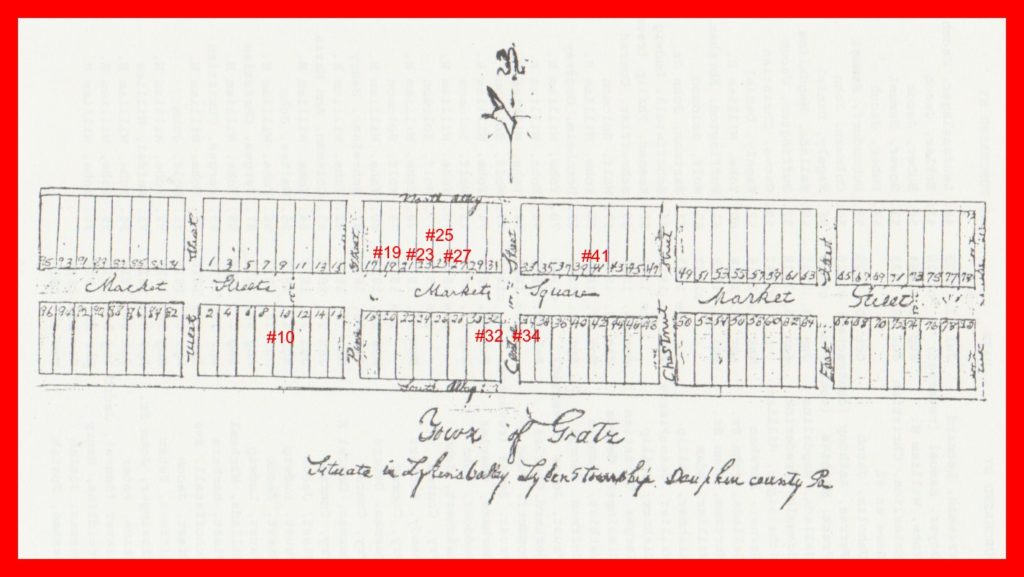
A representation of the original Simon Gratz plan for the town of Gratz, Dauphin County, Pennsylvania, with speculative notations as to where the earliest houses were located.
The question as to when the first houses were built in what is now the Borough of Gratz, Dauphin County, Pennsylvania, has never been conclusively answered.
(1) Most writers have indicated that Gratz was founded in 1805, and both the sesquicentennial in 1955 and the bicentennial in 2005 supported this notion. However, no specific facts have been seen to support this.
(2) Simon Gratz, who is considered to be the founder of Gratz, and the one who laid out the town, did not inherit the land until his adopted father, Aaron Levy, died in 1815.
(3) There is no confirmed date on when Simon Gratz actually laid out the town of Gratz. Would it be reasonable to assume that he could not have laid out a town on land he did not actually own?
(4) There is no record that Simon Gratz sold any of the lots he laid out in his town plan until after 1815.
(5) There is no actual record that any houses were built within the town plan area until after 1815, and there is only a supposition without proof that one house was built in 1815.
(6) Most discussions of the first houses built in Gratz favor the early white settlers and conveniently ignore one of the early settlers of the town, Peter Crabb, an African American.
Consider the following from the Gratz history published in 1997, p. 76.
FIRST HOUSES IN GRATZ
Through a variety of traditions brought down to us from earlier times, several early settlers have been named as “first residents” of Gratz. Some of their homes have been identified. One of the early settlers, Ludwig Schoffstall is mentioned as having built a two-story log, the first house in Gratz, This house was probably on the site of the early tavern on lot thirty-two [#32], A deed has not been found transferring land from Simon Gratz to Ludwig Schoffstall. This leads to the conclusion that Ludwig Schoffstall may have been a “squatter” on the land. It probably also may account for the legal suit Schoffstall won against Simon Gratz.
Another very early house was built on lot number thirty-four [#34], the present [1997] site of the beautiful turn of the century home owned by Roy Wiest. The early log structure had been built probably by Jacob Fagely about 1815, was owned by Rev. Hendel, later owned by Mathias Bellon the inn keeper.
Still another old house is the one on lot number nineteen [#19]. This structure was built by Adjonah Mathias about 1820 and is now one of the oldest existing structures in town.
The house on lot number twenty-three [#23] belonged to Simon Gratz for many years and probably there at least by 1820 and is now one of the oldest structures in town.
Lot number twenty-five [#25] also has an old structure believed to date to about 1819, and built for John Reichard. The adjoining lot, number twenty-seven [#27], most certainly must be considered a very early residence because it was built by Leonard Reedy at least by about 1819.
Two other old houses were never mentioned in recorded history in “competition” for first houses. These two buildings of early construction are still standing on lots numbered 10 [#10] and 41 [#41]. Both probably built before 1820.
Research is ongoing into the question of the founding of the town of Gratz.
It must be noted that in 1905, a Gratz centennial was not celebrated, and only mentioned in one newspaper article thus far located. See:
It also must be noted that Millersburg, which claims to have been founded in 1807, did actually celebrate its centennial in 1907, with much fanfare as already noted in many past posts on this blog. See: Millersburg Centennial.
__________________________________
Corrections and additional information should be added as comments to this post.